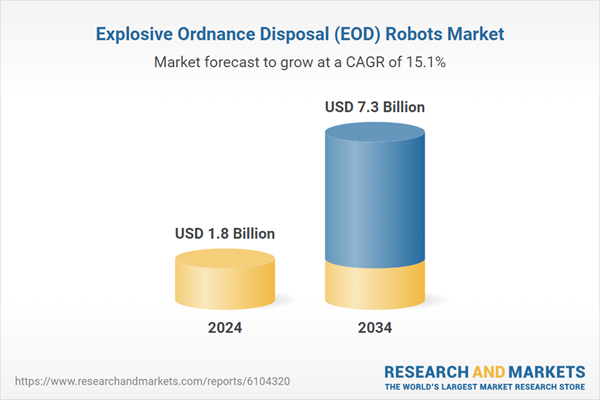The integration of robotics in explosive ordnance disposal tasks is no longer a niche capability but a critical asset for modern armed forces and security agencies. These robots are increasingly viewed as a frontline solution for tackling explosive hazards in unpredictable scenarios, making them indispensable in both battlefield and civilian operations. Their deployment not only enhances situational awareness and decision-making but also significantly cuts operational costs and personnel risk. As a result, procurement of robotic platforms continues to rise as militaries adapt to asymmetric threats and law enforcement looks for reliable tools in urban environments.
Within the market, EOD robots are categorized by type into remote-controlled and autonomous/semi-autonomous variants. In 2024, remote-controlled robots led the market with a valuation of USD 1.14 billion. Their popularity is rooted in their reliability and affordability, which makes them accessible to a wide range of users, including tactical units and security agencies. Manual control remains essential in scenarios where real-time judgment is crucial, and operators prefer systems that respond instantly to human commands. These platforms are also relatively easier to operate, demand minimal regulatory clearance, and are widely preferred in deployments that require adaptability and real-time oversight.
In terms of end use, the defense and military sector was the leading contributor, accounting for 59% of the global market share in 2024. This dominance is driven by the sector’s substantial reliance on robotic systems for tasks such as improvised explosive device (IED) neutralization, tactical reconnaissance, and logistical support in hostile environments.
Armed forces across the globe are prioritizing the integration of robotics into their defense strategies to minimize soldier exposure and improve mission success rates. Ongoing investments in force modernization, alongside greater alignment with command, control, communications, computers, intelligence, surveillance, and reconnaissance (C4ISR) networks, are further strengthening this segment’s lead.
When segmented by operational range, short-range EOD robots dominated the market with a value of USD 821.7 million in 2024. These robots are widely used in urban missions, restricted spaces, and civil operations due to their ease of mobility and suitability for fast-response deployments. Their compact designs and high maneuverability make them ideal for law enforcement, first responders, and bomb squads who need effective tools for localized threats. As security challenges grow in densely populated areas, the demand for such systems is expected to remain strong throughout the forecast period.
Mobility is another key area of segmentation, with robots being divided into tracked, wheeled, legged, and hybrid formats. Among these, tracked robots accounted for a 46.1% market share in 2024. These systems are particularly valued for their superior traction and stability on uneven or debris-filled terrain, which makes them especially useful in combat zones and post-explosion environments. Their rugged construction allows them to carry heavier payloads and operate in harsh conditions, making them the preferred choice for both military and tactical operations.
The United States represented a significant share of the global market, with a valuation of USD 631.5 million in 2024. The country’s leadership in this space is fueled by its high defense spending, continuous overseas deployments, and strategic focus on protective technologies for military personnel. The robust demand for advanced EOD systems in the U.S.
is also driven by government initiatives that support research and procurement, particularly through agencies such as the Department of Defense and Department of Homeland Security. Technological advancements in artificial intelligence and automation are further propelling the adoption of next-generation robotic solutions within national security frameworks.
The competitive landscape of the EOD robots market features both established global players and agile regional manufacturers. The top four companies - L3Harris Technologies, Inc., QinetiQ, iRobot Corporation, and Peraton - collectively held a market share of 41.4% in 2024. These leading firms benefit from long-term defense contracts, broad distribution networks, and ongoing investment in R&D. Their dominance is reinforced by strong relationships with government defense bodies and a track record of innovation in unmanned systems.
Meanwhile, emerging players are carving out their space by offering specialized, cost-effective solutions tailored to niche applications in law enforcement and civilian security. Collaborative development efforts between private firms and public defense organizations are also accelerating product innovation and reshaping the dynamics of market competition.
Comprehensive Market Analysis and Forecast
- Industry trends, key growth drivers, challenges, future opportunities, and regulatory landscape
- Competitive landscape with Porter’s Five Forces and PESTEL analysis
- Market size, segmentation, and regional forecasts
- In-depth company profiles, business strategies, financial insights, and SWOT analysis
This product will be delivered within 2-4 business days.
Table of Contents
COMPANIES MENTIONED
The companies featured in this explosive ordnance disposal (eod) robots market report include:- Boston Dynamics
- Elbit Systems Ltd.
- Foxtech Robotics
- ICOR Technology
- iRobot Corporation
- L3Harris Technologies, Inc.
- Nex Robotics
- Peraton
- PIAP
- QinetiQ
- Reamda Ltd.
- Roboteam
- Shark Robotics
- SuperDroid Robots
- Teledyne FLIR LLC
Table Information
| Report Attribute | Details |
|---|---|
| No. of Pages | 160 |
| Published | June 2025 |
| Forecast Period | 2024 - 2034 |
| Estimated Market Value ( USD | $ 1.8 Billion |
| Forecasted Market Value ( USD | $ 7.3 Billion |
| Compound Annual Growth Rate | 15.1% |
| Regions Covered | Global |
| No. of Companies Mentioned | 16 |









